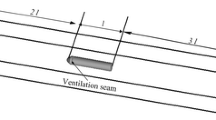Abstract
In order to determine artificial ventilated cavity shape and provide design reference for engineering applications, the shape of ventilated cavity and the drag of underwater body have been numerically simulated with commercial code in this work. Empirical formulas between ventilated cavity shape and cavitation number are obtained under the conditions of zero incidence and similarity shapes of ventilated cavity and vapor cavity have been validated under the same cavitation number. In addition, the relations between change of cavitator incidence and cavity unsymmetry and the relations of between drag and cavity shape have been primarily analysed. Furthermore, the numerical results fit well with the experimental results.
Similar content being viewed by others
References
ZHOU Guang-jiong. Fluid mechanics (I)[M]. Beijing: Higher Education Press, 1993, 290–291. (in Chinese)
NIE Rong-sheng. Cavity and cavitation in turbopump[M]. Beijing: Higher Education Press, 1985, 2–6. (in Chinese)
YUAN Xu-long, ZHANG Yu-wen, WANG Yu-cai et al. On asymmetry of ventilated supercavity of underwater vehicle[J]. Acta Mechanica Sinica, 2004, 36(2): 146–150. (in Chinese)
SONG C. S. Flutter of supercavitating hydrofoils comparison of theory and experiment[J]. Journal of Ship Research, 1972,16 (3):153–166.
WU Lei, LU Chuan-jing, XUE Lei-ping. An approach in 279 modeling two-dimensional partially cavitating flow[J]. Journal of Hydrodynamics, Ser. B, 2002,14(1):45–51.
KINNAS S. A., MAZEL C. H. Numerical versus experimental cavitation tunnel (A supercavitating hydrofoil experiment) [J]. Asme Journal of Fluids Engineering, 1993, 115:760–765.
VLASENKO Y. D. Experimental investigations of high speed unsteady supercavitating flows[A]. Proceedings of Third International Symposium on Cavitation][C]. Grenoble, France, 1998, 2: 226–245.
REICHARDT H. Cavitation investigation on henschel water - running bodies[R]. Ministry of Supply (British),Transl. 62 (from Germany), 1946.
PHILLIP B. Behm. Experimental study of a ventilated supercavitating vehicle[J]. J. Fluid Mech., 1993, 254:131–150.
INGBER M. S., HAILEY C. E. Numerical modeling of cavities on axisymmetric bodies at zero and non-zero angle of attack[J]. Journal for Numerical Methods in Fluid, 1992,15: 251–271.
SAVCHENKO Y. N. Modeling the supercavitation processes[J]. International Journal of Fluid Mechanics Research, 2001, 28(5): 644–659.
FENG Xue-mei, LU Chuan-jing, HU Tian-qun et al. The fluctuation characteristics of natural and ventilated cavities on an axisymmetric body[J]. Journal of Hydrodynamics, Ser. B, 2005, 17(1):87–91.
WANG Hai-bin, ZHANG Jia-zhong, WEI Ying-jie et al. Study on relations between cavity form and typical cavitor parameters[J]. Journal of Hydrodynamics, Ser. A, 2005, 20(2):251–257. (in Chinese)
XIE He You-sheng, ZHU Shi-quan. An experimental study on cavitating slender body at small angles of attack[J]. Journal of Hydrodynamics, Ser. A, 2001, 16(3):374–381. (in Chinese)
FU Lu Chuan-jing, WU Lei. Research on characteristics of flow around cavitating body of revolution[J]. Journal of Hydrodynamics, Ser. A, 2005,20(1):84–89. (in Chinese)
LIU Hua, LIU Qing-hua, HU Tian-qun. An experimental study on fluctuating hydrodynamic loads on cavitating axisymmetric slender bodies[J]. Journal of Hydrodynamics, Ser. A, 2004,19(6):794–800. (in Chinese)
WU Lei. Numerical simulations of cavitating flows[J]. Journal of Hydrodynamics, Ser. B, 2003, 15(4):125.
Author information
Authors and Affiliations
Corresponding author
Additional information
Biography: JIA Li-ping (1977-), Female, Ph. D.
Rights and permissions
About this article
Cite this article
Jia, Lp., Wang, C., Wei, Yj. et al. Numerical Simulation of Artificial Ventilated Cavity. J Hydrodyn 18, 273–279 (2006). https://doi.org/10.1016/S1001-6058(06)60003-6
Received:
Published:
Issue Date:
DOI: https://doi.org/10.1016/S1001-6058(06)60003-6



